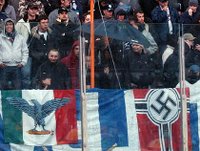This is a Call for Papers from the CePog (Centre of Postcolonial
and Gender Studie) University Trier
Call for Papers
Slavery in Contemporary Art. Trauma, Theory and Tradition in Visual Culture
An intercultural and interdisciplinary conference hosted by the
Centre for Postcolonial and Gender Studies at the University of
Trier (October 26-28, 2006)
Submission deadline: March 31, 2006.
Slavery, both in its historical and modern forms, continues to be a
matter of undiminished political and social relevance. Since the
1980s there has been an increasing artistic interest in this topic
with a number of artists working on the subject of slavery. The
significance of their concepts of memory has not only emerged in
their call for alternative images of history but also in their reflections
and attempts to come to terms with the after-effects of slavery. In
spite of a prevailing general interest in slavery, however these
works of art and the individual reflections they express have been
met with little scholarly attention so far.
This conference is designed to bring together scholars and artists
from various disciplines and fields of study, and specifically
addresses graduates, post-graduates and junior scholars/ artists.
Its aim is to consider visual representations, critiques and revisions
of slavery in contemporary art. These can be considered as
instances of cultural transformation, denial, and exposure of
historical traumas. In this sense, paintings and artifacts are no
more illustrations of historical or contemporary events but rather
culturally coded aesthetic symptoms. Interpretations of these
visually coded symptoms provide insights into the history of
mentalities and affects that cannot otherwise be gained. This
approach calls for particular theories and methods yet to be
formulated, which also take into account more established
approaches such as postcolonial and gender studies, media
theory, and discourse analysis.
The conference wants to give an impetus to the formulation of a
theory that considers trauma and visual representation from a
postcolonial perspective. The aim is to develop a transcultural
differentiated paradigm of pictures, which allows for the
international interchange of visual cultures of memory. A special
focus will be given to critical discussions of psychoanalytic
approaches to trauma within the cultural studies - with the objective
of checking the colonising impact of such approaches and
counteracting their universal application to all manifestations of
culture. One question could be whether such approaches are not in
and of themselves specific euro-american attempts or strategies of
coming to terms with traumatic experiences.
While the conference focuses on slavery, we highly welcome
theoretical and methodological contributions from other relevant
areas, such as holocaust and genocide studies as well as studies
of the aftermath of armed conflicts. We welcome all contributions
dealing with visual discourse strategies of memory and repression,
projection, metaphorical displacement, and the inversion of
meaning.
Presentation topics may include:
* Theoretical and artistic concepts of trauma and visuality
* The impact of traumatic experiences on the formation of body
images. What affects and/or bodily experiences do these symptom
formations evoke?
* Besides visual symptom formations, what other (performative,
verbal or acoustic) traditions do exist, that deal with historical
attempts of coming to terms with the trauma of slavery or the
(partial) failure of abolitionism? The emphasis should be on
mediality under which traumas are being dealt with.
* How does contemporary art criticise traditional visual
representations of slavery? In what terms can the processes of
decoding and recoding be described?
We invite interdisciplinary contributions from history, literary
studies, musicology, cultural studies, history of art, media studies,
ethnology, sociology, narratology, psychology, and philosophy as
well as from the arts and all adjacent fields. As the conference will
be held in English, only English contributions will be considered.
Submission deadline:
Please e-mail your proposals (not exceeding 300 words), your
address, and a short bio, by March 31, 2006 to:
Slavery-Conference@web.de
Birgit Haehnel
and
Melanie Ulz
CePoG: "Slavery in Contemporary Art"
Centre for Postcolonial and Gender Studies
FB III - Kunstgeschichte, Universität Trier
Universitätsring 15
D-54296 Trier
Germany
Phone: +49 - (0)651 - 201 - 2182
Fax: +49 - (0)651 - 201 - 3850
Homepage: http://www.uni-trier.de/cepog





